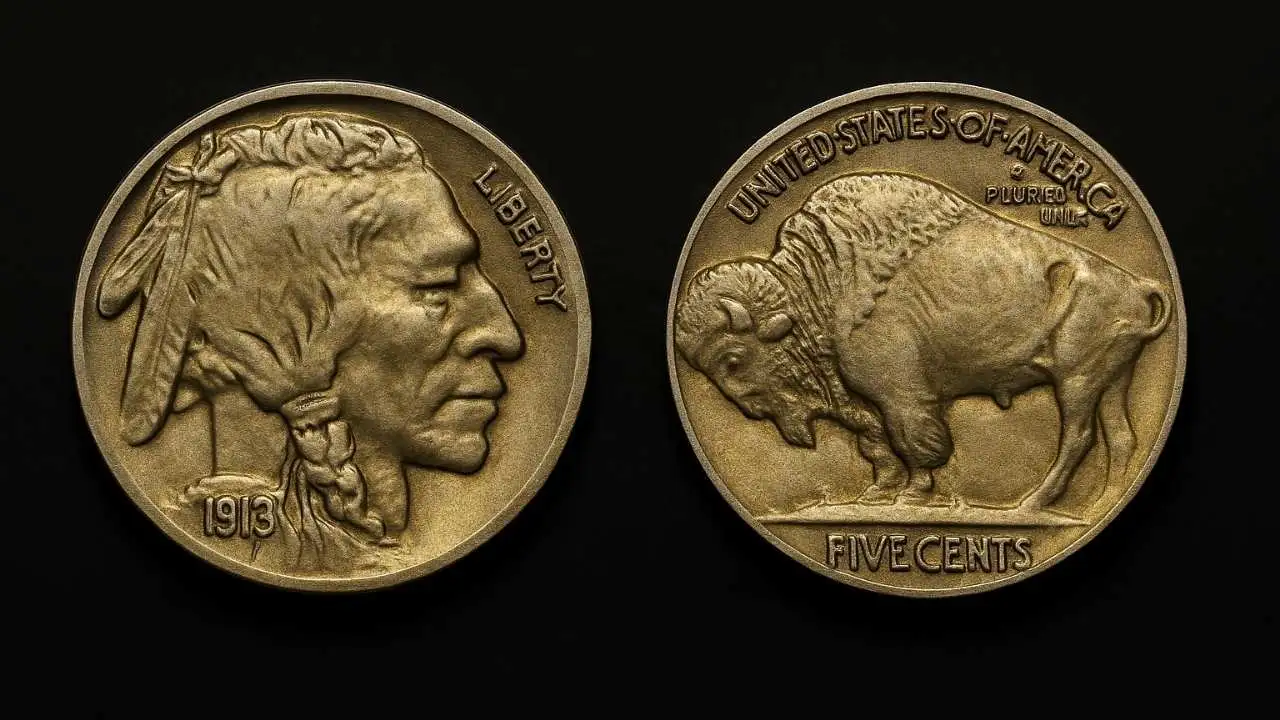The Buffalo Nickel, also known as the Indian Head Nickel, remains one of the most cherished pieces in American numismatic history. First minted in 1913, this iconic coin embodies artistry, heritage, and national identity. Recently, a 1913 Philadelphia issue — one without a mintmark — stunned collectors when it sold for $55,200 at auction.
While millions of these coins were minted, few have survived in pristine condition. For collectors and enthusiasts alike, the sale serves as a reminder that sometimes, history hides in plain sight — perhaps even in your change jar.
“Condition is everything when it comes to Buffalo Nickels. The difference between a common piece and a $50,000 treasure can be subtle but significant,” says coin grading expert Michael Sanders.
Rare 1913 Buffalo Nickel Without Mintmark
The Buffalo Nickel was designed by James Earle Fraser, an American sculptor who sought to capture the rugged spirit of the American frontier. His goal was to create a coin that symbolized the cultural heritage of the United States while celebrating its native wildlife.
Production began in 1913, replacing the Liberty Head Nickel. The design quickly captivated the public, becoming both a symbol of the nation’s strength and a favorite among collectors.
Fraser’s design would go on to influence generations of coin artists, and even today, the Buffalo motif continues to appear on modern U.S. bullion coins like the American Buffalo Gold Coin.
The 1913 Buffalo Nickel: Key Details
The 1913 Buffalo Nickel minted in Philadelphia — cataloged as PCGS #3937 — holds a unique place in U.S. coinage. Here are its defining specifications:
| Attribute | Specification |
|---|---|
| Mint | Philadelphia (no mintmark) |
| Composition | 75% copper, 25% nickel |
| Weight | 5.00 grams |
| Diameter | 21.20 mm |
| Edge | Plain |
| Designer | James Earle Fraser |
| Mintage | 32,056,000 |
| Type | Type 1 (raised ground under the bison) |
Unlike coins from Denver (D) or San Francisco (S), Philadelphia’s Buffalo Nickels have no mintmark, making them easily identifiable.
Design: A True Artistic Masterpiece
Fraser’s Buffalo Nickel features two of the most iconic images in American coinage:
Obverse: The Native American Profile
The obverse depicts a proud Native American portrait — not of a single person, but a composite of several chiefs, including Iron Tail (Sioux), Big Tree (Kiowa), and Two Moons (Cheyenne). This choice represented a unifying image honoring Indigenous heritage.
Reverse: The American Bison
The reverse displays a majestic American bison standing atop a mound. This is known as the Type 1 design, used early in 1913 before it was modified to a flatter base for durability.
Collectors appreciate this early design for its naturalism and depth — qualities that made the coin prone to wear but also gave it lasting visual impact.
“Fraser’s bison isn’t just a design; it’s a statement about the American spirit,” notes art historian Linda Frazier.
Why the 1913 Nickel Without Mintmark Is So Valuable?
Despite a mintage exceeding 32 million, most 1913 Philadelphia Buffalo Nickels circulated heavily. Over time, their raised details wore down, making high-grade examples extremely rare.
When a specimen surfaces in superb condition — exhibiting full detail, clear texture, and minimal wear — collectors bid aggressively. That’s exactly what happened when one pristine piece sold for $55,200 at auction.
Factors contributing to such high value include:
- Uncirculated grade (MS66 or higher)
- Strong strike and minimal blemishes
- Original luster
- Attractive toning or coloration
Even lower-grade examples can sell for $20 to $100 depending on their condition, making them accessible to newer collectors.
Auction and Collector Demand
In recent years, Buffalo Nickels — especially early issues — have surged in popularity. Major auction houses like Heritage Auctions and Stack’s Bowers continue to feature them in premium sales.
The $55,200 sale exemplifies how condition and historical context can elevate a coin’s worth far beyond its face value. High-grade 1913 Type 1 nickels remain among the most coveted of the series.
Other Notable Auction Prices:
| Grade (PCGS) | Auction Price |
|---|---|
| MS67 | $55,200 |
| MS66+ | $35,000 |
| MS65 | $9,000 |
| MS64 | $3,800 |
| MS63 | $1,600 |
“Collectors are rediscovering early 20th-century artistry, and the Buffalo Nickel represents that golden era perfectly,” says David Halpern, senior numismatist at Coin World.
Legacy: The Enduring Symbolism of the Buffalo Nickel
The Buffalo Nickel wasn’t just currency — it was art in circulation. Its imagery captured a time when America was rapidly modernizing but still deeply connected to its frontier roots.
Even after production ended in 1938, the design continued to inspire coins like the 2001 American Buffalo Silver Dollar and the 24-karat Gold Buffalo bullion coin released by the U.S. Mint.
Today, the Buffalo Nickel stands as a timeless reminder of American resilience, craftsmanship, and identity.
How to Identify a Valuable 1913 Buffalo Nickel?
If you think you might have one of these coins, here’s what to look for:
- No mintmark under the date (Philadelphia issue)
- Raised mound beneath the buffalo — indicating Type 1 design
- Strong details in the Native American’s hair and the bison’s fur
- Unworn surfaces or visible mint luster
Collectors can check their coins using a magnifier and compare them to online images from grading services such as PCGS or NGC.
Coin Grading and Preservation
Grading is key to determining a coin’s value. Professional services like PCGS (Professional Coin Grading Service) and NGC (Numismatic Guaranty Company) assess coins on a 70-point scale, where MS60–MS70 denotes mint-state quality.
To preserve value:
- Store coins in acid-free holders or airtight capsules
- Avoid cleaning, which can damage the surface
- Handle coins only by the edges to prevent oils from tarnishing them
Conclusion: A Small Coin with Big History
The 1913 Buffalo Nickel without mintmark is more than just an antique — it’s a symbol of America’s cultural and artistic evolution. Its recent $55,200 sale reaffirms the continued fascination collectors have with this enduring design.
So, the next time you stumble upon an old nickel, take a closer look. You might just be holding a piece of history — and perhaps, a small fortune.
FAQs
Why doesn’t the 1913 Buffalo Nickel have a mintmark?
It was minted in Philadelphia, which didn’t use mintmarks in 1913.
What is the Type 1 Buffalo Nickel?
It features a raised mound beneath the buffalo, used only in early 1913 before being redesigned.
How much is a regular 1913 Buffalo Nickel worth?
Depending on condition, values range from $20 to over $50,000 for mint-state coins.
Who designed the Buffalo Nickel?
James Earle Fraser, an acclaimed American sculptor and designer.
How can I tell if my coin is valuable?
Check for sharp details, lack of wear, and no mintmark. Having it graded by PCGS or NGC is the best way to confirm its authenticity and value.

